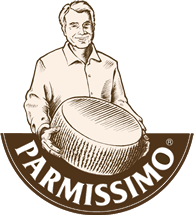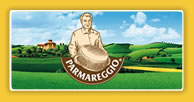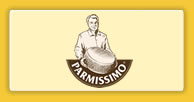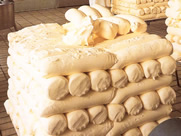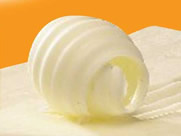 Nutritional - the connoisseur
Nutritional - the connoisseurFollow me and discover the tasty world of Parmigiano Reggiano, a food whose nutritional qualities make it suitable for people of all ages. I'll tell you about when Parmigiano Reggiano was born, about 900 years ago. A story of time-honoured taste.
Butter: history and nutritional value
Did you know that Parmareggio butter is made solely with cream produced by dairies located in the provinces of Parma, Reggio Emilia and Modena? And it's exactly that fresh cream that gives it that unique and unmistakable taste. This is why a connoisseur like me is crazy about Parmareggio Butter.
Its delicate and creamy taste makes it versatile and the ideal ingredient to dress first courses or prepare tasty hot dishes. Also delicious spread on bread.
Just like Parmigiano Reggiano, butter has a beautiful story that dates back over 2000 before Christ, even though the precise date is unknown. There are many legends that attribute different origins to the product.
At first, the use of butter was not closely linked to the food sector; it was also used in cosmetics and medicine as a healing ointment.
The origin of the word "boutiron" is attributed to Shiites who lived in the areas skirted by the Danube and the Don between the 7th and 2nd century B.C. However, it is thought that butter was invented by the people who lived in the northern regions, because churning requires a temperature around 15°C, which is easily reached in cooler regions. Other sources attribute the art of making butter as a food so good and nutritious to be mentioned in the Old Testament, to the ancient Jews. In his encyclopaedic work of the 1st century A.C., Natural History, Pliny the Elder wrote "... from milk, too, butter is produced; held as the most delicate of food among barbarous nations ...".
Did you know that Parmareggio butter is made solely with cream produced by dairies located in the provinces of Parma, Reggio Emilia and Modena? And it's exactly that fresh cream that gives it that unique and unmistakable taste. This is why a connoisseur like me is crazy about Parmareggio Butter.
Its delicate and creamy taste makes it versatile and the ideal ingredient to dress first courses or prepare tasty hot dishes. Also delicious spread on bread.
Just like Parmigiano Reggiano, butter has a beautiful story that dates back over 2000 before Christ, even though the precise date is unknown. There are many legends that attribute different origins to the product.
At first, the use of butter was not closely linked to the food sector; it was also used in cosmetics and medicine as a healing ointment.
The origin of the word "boutiron" is attributed to Shiites who lived in the areas skirted by the Danube and the Don between the 7th and 2nd century B.C. However, it is thought that butter was invented by the people who lived in the northern regions, because churning requires a temperature around 15°C, which is easily reached in cooler regions. Other sources attribute the art of making butter as a food so good and nutritious to be mentioned in the Old Testament, to the ancient Jews. In his encyclopaedic work of the 1st century A.C., Natural History, Pliny the Elder wrote "... from milk, too, butter is produced; held as the most delicate of food among barbarous nations ...".
A product which distinguishes the wealthy from the multitude at large. Butter, the condiment of northern people, the "Barbarians" versus olive oil, used by Romans
and Greeks, the "civilised" people. A contraposition that represented the contrast between civilization and barbarism during the ancient times.
In modern age, butter became an elite product. In a mid 18th century work, Vincenzo Tanara reported that, in ancient times, butter marked the separation between the noble and the plebeian, the rich and the poor, because the poor could not afford to use it due to its high price.
In the past, besides being considered a highly nutritional food, butter was thought to have therapeutic properties.
Its composition and, in particular, the fatty acids it contains, make it highly digestible. This derives from the fact that butter's fatty acids have a melting point around 30 °C; therefore, below body temperature, and this makes it easily absorbed by the liver that transforms them into energy.
Given the high content of fats and its easy and quick digestibility, butter is a very energetic food, ideal for sportspeople.
Not everybody knows that, as hypercaloric as it may be, butter is rich in vitamin A and mineral salts, which makes it ideal for the younger ones and defends them against infections. Butter spread on rusk for breakfast will provide your children with the energy for the day ahead.
Moreover, butter is one of the few foods that contains vitamin D, which promotes calcium metabolism, essential for bone growth and health.
In modern age, butter became an elite product. In a mid 18th century work, Vincenzo Tanara reported that, in ancient times, butter marked the separation between the noble and the plebeian, the rich and the poor, because the poor could not afford to use it due to its high price.
In the past, besides being considered a highly nutritional food, butter was thought to have therapeutic properties.
Its composition and, in particular, the fatty acids it contains, make it highly digestible. This derives from the fact that butter's fatty acids have a melting point around 30 °C; therefore, below body temperature, and this makes it easily absorbed by the liver that transforms them into energy.
Given the high content of fats and its easy and quick digestibility, butter is a very energetic food, ideal for sportspeople.
Not everybody knows that, as hypercaloric as it may be, butter is rich in vitamin A and mineral salts, which makes it ideal for the younger ones and defends them against infections. Butter spread on rusk for breakfast will provide your children with the energy for the day ahead.
Moreover, butter is one of the few foods that contains vitamin D, which promotes calcium metabolism, essential for bone growth and health.
